

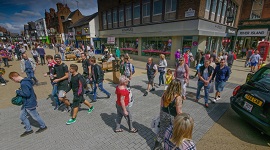 Mott MacDonald and IBI carried out stakeholder engagement to listen to their requirements and aspirations. Receiving this early feedback, Mott MacDonald and IBI analysed a series of case studies to determine how the key project requirements had been delivered elsewhere. Using their experience, together they produced a scheme which was designed to improve not only the fabric but the whole pedestrian experience.
Mott MacDonald and IBI carried out stakeholder engagement to listen to their requirements and aspirations. Receiving this early feedback, Mott MacDonald and IBI analysed a series of case studies to determine how the key project requirements had been delivered elsewhere. Using their experience, together they produced a scheme which was designed to improve not only the fabric but the whole pedestrian experience.
This was achieved by making Frodsham Street a pedestrian priority area, sympathetic to the historical setting, encouraging pedestrians to dwell. The general layout was to have a shared central zone to the street in coloured asphalt, with pedestrian only zones down either side, in Yorkstone, which were completely free of street furniture. Feature bollards were used to provide heritage information and form the pedestrian zone.
Tactile paving informed blind/partially sighted pedestrians when they were crossing from the pedestrian only zone to the shared zone. Delivery vehicles parked along the road, to prevent the Yorkstone surfacing from breaking. A rigid construction was used to reduce maintenance.
Judges' Comments
"This project demonstrated a clear achievement of the scheme objectives, creating a shared space within a retail environment delivering a great balance between movement and place functionality. Through effective consultation, option review and well executed implementation this scheme has contributed to retail business growth alongside safe inclusive accessibility winning praise from in particular, from blind and partially sighted access groups."
The Royal Borough of Kingston upon Thames’s flagship Go Cycle Portsmouth Road scheme was completed by Kier in April 2017 - the first under a £30m sponorship from the Mayor of London and Transport for London’s Mini-Holland initiative.
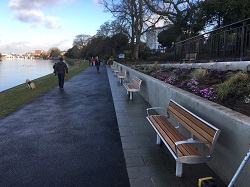
The Royal Borough of Kingston upon Thames’s flagship Go Cycle Portsmouth Road scheme was completed by Kier in April 2017 - the first under a £30m sponorship from the Mayor of London and Transport for London’s Mini-Holland initiative.
A neglected part of the Thames embankment was converted into 1.6km of state-of-the-art cycle tracks linking Surbiton and Thames Ditton to Kingston Town Centre. Creative place-making has established Portsmouth Road as a destination, revitalising the community’s connection with the River and reviving the area’s economy. The scheme is an exemplar of the Mayor of London’s Healthy Streets agenda, normalising active travel for all whilst offering a peaceful sanctuary from a busy metropolitan environment.
Judges' Comments
"Delivered under the Mayor of London’s Healthy Streets initiative this scheme has generated a significant increase in cycling and walking across a wide local demographic, with demonstrable high levels of satisfaction with the improved environment for both leisure activity and commuters alike. The design has also taken due consideration for the long term functionality and maintainability of the asset."
As the focal point of our Enjoy Waltham Forest Leyton Town Centre scheme, the tired and neglected Francis Road shopping area has recently been regenerated into an attractive high street to invigorate local businesses and encourage local people to use and enjoy their community shopping area.
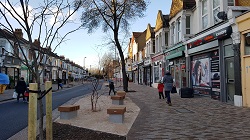
As the focal point of our Enjoy Waltham Forest Leyton Town Centre scheme, the tired and neglected Francis Road shopping area has recently been regenerated into an attractive high street to invigorate local businesses and encourage local people to use and enjoy their community shopping area.
The scheme’s vision aims to:
Judges' Comments
"This scheme has fulfilled the vision of transforming a functional and blighted streetscape into a thriving high street and place for community interaction. The design and implementation has improved road safety, created a pleasant street scene environment and increase accessibility resulting in increased footfall and consequential local retail business growth."
The Crossrail project includes a visionary agenda to create better streets, places and interchanges through the Crossrail Complementary Measures (CCM) programme. London Borough of Havering (LBH), in partnership with TfL are transforming three Crossrail stations - Romford, Gidea Park and Harold Wood.
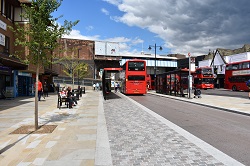
The Crossrail project includes a visionary agenda to create better streets, places and interchanges through the Crossrail Complementary Measures (CCM) programme. London Borough of Havering (LBH), in partnership with TfL are transforming three Crossrail stations - Romford, Gidea Park and Harold Wood.
Jacobs was commissioned to design all three schemes; Romford Interchange Plaza is the first to be completed. Jacobs has been involved from the concept stages and public engagement, through design to completion.
The former bus station in Romford was characterised by street clutter, guardrails, wide carriageways, inadequate footways, unassuming materials and poor legibility to the wider area. The vision was to extend the Crossrail experience beyond the station to create a strong first impression, improve sustainable travel choices, integrate the station into the surrounding urban context and enhance place value. The scheme achieves this by creating an inviting and efficient interchange environment which is a gateway to Romford Town Centre and will be a catalyst for further regeneration in the area.
Grosvenor has worked closely with the City of Westminster for over ten years on the stewardship and enhancement of the London Estates public realm.
The transformed streetscape at rosvenor Hill (completed in 2016) was delivered through a multidisciplinary, collaborative approach from start to finish, funded by Grosvenor, designed by BDP and Urban Flow, managed and costed by Gardiner and Theobald and implemented through the City service providers WSP and FM Conway.
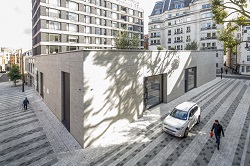
Grosvenor has worked closely with the City of Westminster for over ten years on the stewardship and enhancement of the London Estates public realm.
The transformed streetscape at rosvenor Hill (completed in 2016) was delivered through a multidisciplinary, collaborative approach from start to finish, funded by Grosvenor, designed by BDP and Urban Flow, managed and costed by Gardiner and Theobald and implemented through the City service providers WSP and FM Conway.
Grosvenor’s vision was to transform Grosvenor Hill from a quiet and neglected backwater into a reimagined creative district. The area formerly comprised a car park, garages, offices, flats and servicing activity. It was characterised by relatively poor public realm which prioritised cars, some underwhelming architecture and low footfall.